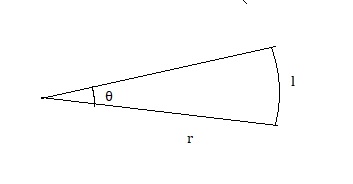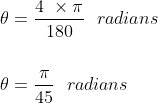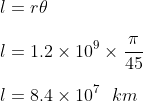Question

Transcribed Image Text:If you saw Comet Halley when the comet was 0.8 AU from Earth and you observed a visible tail 4 degrees long, how long was the tail in kilometers?
(Hint: Use the small-angle formula.) (Note: 1 AU = 1.5 x 10° km.)
X km
Expert Solution
arrow_forward
Concept
For Small-angle approximation
The arc length at distance r and angle θ is given by


arrow_forward
Answer
The comet distance from the earth is r = 0.8 AU
Now 1 AU = 1.5 × 109 km
Thus
r = 0.8 × 1.5 × 109 km
r = 1.2 × 109 km
Angle to tail length from the earth is θ = 4 degrees
Now

Thus

The length of the comet tail is given by

Step by stepSolved in 3 steps with 5 images

Knowledge Booster
Similar questions
- Astronomers are able to use techniques like measuring the Question Blank 1 of 2 (hint: two words) of a surface to determine the relative age of various parts of that surface. However, if they want a(n) Question Blank 2 of 2 (hint: one word) age of the surface, they need to collect surface samples and then radiometrically date them to get a more exact measurement.arrow_forwardAnnual meteor showers occur when the Earth passes through the orbital path of acomet. The intensity of these showers vary from year to year. Which of the following may bethe reason for this? Group of answer choices - Meteor showers are not caused by comet debris - Sun's temperature - en distribution of debris along comet's orbit - Earth's rotation axisarrow_forwardRe-order the numbers so the events occur in the correct order, with the oldest event as number 2, and the youngest event as number 13. 2. Now at roughly 100% of present-day mass and the asteroid bombardment over, Earth begins cooling and differentiating. As the outer layer of the Earth cools and solidifies, lighter elements and compounds rise to the surface while the denser ones sink to the core 3. The now differentiated ice, gas, and dust of the solar accretion disc conglomerates together into asteroids from gravity 4. "The Big Whack" A Mars-sized protoplanet we call Theia collides with primitive Earth, adding even more energy and mass 5. The Big Bang 6. As the early atmosphere cools, water vapor is eventually cool enough to condense into liquid water, eventually covering the planet in an ocean 7. The debris from the collision of Earth and Theia produce a ring in orbit. This ring eventually coalesces into the Moon, just as Earth coalesced from the solar accretion disc 8. A nebula…arrow_forward
- Let's assume it took Voyager 1 13 years to reach the edge of solar system at a distance of 40 AU. How fast was voyager 1 traveling in Km/hr?arrow_forwardIf the velocity of the Solar Wind about 4.0 x 10^2 km/s and the visible tail of a comet of 9.0 x 10^8 km long, how many days does an atom in the solar wind take to travel from the nucleus to the end of the visible tail? (note: 1 day= 86,400 sec) _______ daysarrow_forwardA typical comet contains some 1013 kg of water ice. How many comets would have to strike Earth in order to account for the roughly 2×1021 kg of water presently found on our planet? (Hint: simple division) If this amount of water accumulated over a period of 500 million years, how frequently must Earth have been hit by comets during that time? (Hint: Calculate, on the average, how many comets hit the Earth per year during that time.)arrow_forward
- Why do we see comet Halley only every 76 years? Explain your reasoning.arrow_forwardIf you were to record the spectrum of Saturn as well as the A ring, you would find light from one edge of the rings redshifted and light from the other edge blueshifted. If you observed a spectral line at a wavelength of 505 nm, what difference in wavelength (in nm) should you expect between the opposite edges of the rings? (Hints: The radius of the edge of the A ring is 136,500 km. Use the formula for orbital velocity,arrow_forwardCalculate the orbital period of a comet nucleus in the Oort cloud.arrow_forward
arrow_back_ios
arrow_forward_ios